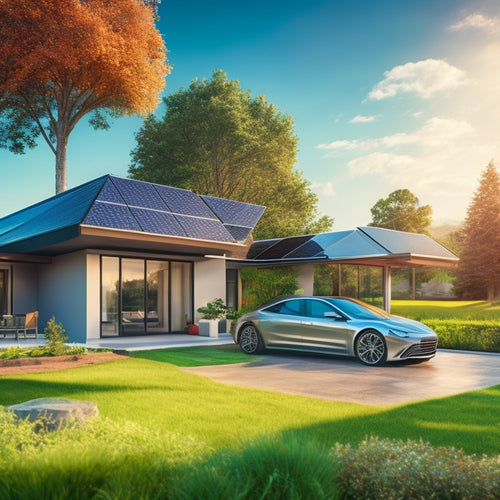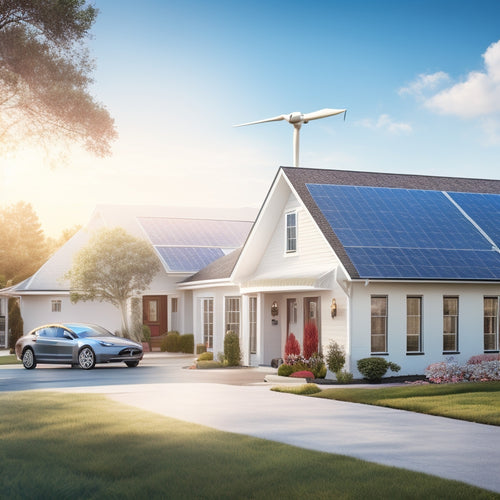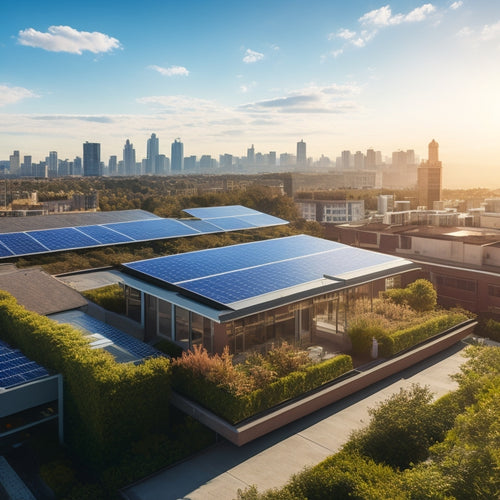
How to Get an Accurate Rooftop Solar Installation Cost Estimate
Share
To get an accurate rooftop solar installation cost estimate, you'll need to assess your energy needs by analyzing your utility bills and identifying your energy usage patterns. Evaluate your roof's condition to verify it can support the weight of solar panels. Research local solar installers, considering their licenses, experience, and customer reviews. Determine the system size you need and choose the right equipment, including solar panels and inverters. Understand local incentives and rebates, and get multiple quotes from installers to compare prices and services. By doing your due diligence, you'll get a thorough estimate that sets you up for a successful solar installation - and there's more to investigate to guarantee you make an informed decision.
Key Takeaways
- Assess energy needs by analyzing utility bills and daily energy usage to determine peak sun hours and energy efficiency goals.
- Evaluate the roof's condition, including age, structural integrity, and potential damage, to ensure suitability for solar panels.
- Research local solar installers, checking licenses, certifications, experience, and customer reviews to ensure a reliable installation.
- Consider system size requirements, equipment choices, and warranties to balance upfront costs with long-term energy savings.
- Gather quotes from multiple installers, comparing prices, services, and financing options to identify discrepancies and ensure an accurate cost estimate.
Assess Your Energy Needs
Assess Your Energy Needs
Typically, your energy consumption patterns over the past year serve as the best indicator of your energy needs. Analyzing your utility bills from the past 12 months can help you understand your energy usage habits.
This exercise is essential in determining how much electricity you need to generate from solar power. You'll want to identify your total energy consumption in kilowatt-hours (kWh) and your peak sun hours, which vary by region.
Your utility bills will provide this information, usually in the form of a yearly summary or a detailed breakdown of your monthly energy usage.
Evaluate Your Roof's Condition
You'll need to assess your roof's age and wear to determine if it's suitable for solar installation.
A structural integrity check is also vital to guarantee your roof can support the weight of the solar panels.
Your roof's condition will greatly impact the installation cost, so it's important to evaluate these factors accurately.
Roof Age and Wear
Your roof's age and wear play a significant role in determining the overall cost of your solar installation. As a homeowner, you need to reflect on the condition of your roof before installing solar panels. The older your roof, the more likely it is to require repairs or replacement, which can add to the overall cost of your solar installation.
| Roof Age | Impact on Solar Installation Cost |
|---|---|
| 10-15 years old | May require additional roof maintenance, adding $1,000 to $3,000 to the overall cost |
| 15-20 years old | May require roof replacement before installing solar panels, adding $5,000 to $10,000 to the overall cost |
| Over 20 years old | Will likely require roof replacement before installing solar panels, adding $10,000 to $15,000 to the overall cost |
Proper roof maintenance is essential to guarantee the longevity of your solar panels. You should take into account the cost of roof repairs or replacement when calculating the overall cost of your solar installation. This will help you plan and budget accordingly, assuring a smooth and hassle-free installation process.
Structural Integrity Check
At least three key areas of your roof's condition require careful evaluation during a structural integrity check: its overall layout, existing damage, and potential weak spots.
You'll want to assess whether your roof's design and construction can support the added weight of solar panels. This is vital, as solar panels can weigh around 2-3 pounds per square foot, depending on the type and quality.
A thorough evaluation will also identify any existing damage, such as cracks, rot, or sagging, which could compromise the roof's ability to support the solar installation.
Additionally, potential weak spots, like loose or missing tiles, must be addressed before installing solar panels.
A load capacity assessment will determine whether your roof can handle the additional weight of the solar panels, and if structural modifications are necessary.
If modifications are required, this will impact your overall solar installation cost.
Research Local Solar Installers
You'll want to research local solar installers to find the best fit for your project.
Start by checking their local credentials, comparing their installation experience, and verifying the licenses they hold.
This will give you a sense of their proficiency and ability to handle your specific solar installation needs.
Check Local Credentials
Researching local solar installers is an essential step in getting an accurate solar installation cost estimate. You want to ascertain the installers you're considering have the necessary credentials to handle your project.
Start by checking if they've the required licenses and certifications to operate in your state and locality. Look for certifications like NABCEP (North American Board of Certified Energy Practitioners) and check if they're listed on the California Solar Initiative's (CSI) Eligible Installer List.
Verify that the installers are compliant with local regulations and have experience obtaining installation permits. You can check with your local government to see if there have been any complaints filed against the installers.
Also, check online review sites like Yelp or Google to see what other customers have to say about their experience with the installers.
Compare Installation Experience
Now that you've narrowed down your list of potential solar installers by checking their local credentials, it's time to compare their installation experience.
You want to verify the installer you choose has a track record of successful projects and satisfied customers. Start by researching each company's installation methods, including the types of equipment they use and their approach to system design. This will give you an idea of their technical knowledge and attention to detail.
Next, read customer reviews from multiple sources, such as Yelp, Google, and the Better Business Bureau. Pay attention to the overall rating and the content of the reviews.
Are customers praising the installer's professionalism, communication, and work quality? Are there any red flags or common complaints?
Verify Licenses Held
Verifying the licenses held by your potential solar installers is an essential step in confirming you're dealing with reputable and competent professionals. This process helps you weed out unqualified contractors and guarantees that your solar installation project is handled by experts who meet the necessary standards.
To verify licenses, you can check with your state's licensing board or the National Association of State Contractors Licensing Agencies (NASCLA) for a list of licensed contractors in your area. You can also ask for proof of licenses and certifications from the contractors themselves.
Here's a sample checklist to help you verify licenses and contractor qualifications:
| License/Certification | Issuer | Verification Method |
|---|---|---|
| Electrical Contractor License | State Licensing Board | Check online database or contact board directly |
| NABCEP Certification | North American Board of Certified Energy Practitioners | Verify certification on NABCEP website |
| OSHA Certification | Occupational Safety and Health Administration | Check OSHA website or ask contractor for proof |
Remember to verify licenses and certifications for all contractors you're considering, and don't hesitate to ask questions or seek clarification if you're unsure about anything.
Determine System Size Requirements
To accurately size your solar panel system, you'll need to calculate your energy usage and determine how much power you want your system to generate. This involves understanding your energy consumption patterns, including your daily energy usage in kilowatt-hours (kWh). You can find this information on your past utility bills or by using an energy monitoring device.
Next, evaluate your energy efficiency goals. Do you want to cover a portion of your energy needs or go completely off-grid? Your energy efficiency goals will influence the size of your solar panel system.
You'll also need to assess the type of solar panel system you want to install. Different solar panel types have varying efficiencies, which affect the overall system size. For example, high-efficiency panels may require fewer panels to generate the same amount of power as lower-efficiency panels.
Choose the Right Equipment
About 20-30% of your overall solar installation cost depends on the equipment you choose. This significant portion of the total cost makes it vital to select the right equipment for your rooftop solar installation.
When it comes to solar panel types, you'll need to decide between monocrystalline, polycrystalline, and thin-film panels. Monocrystalline panels are the most efficient but also the most expensive. Polycrystalline panels are a more affordable option with slightly lower efficiency. Thin-film panels are the least expensive but have the lowest efficiency.
Inverter options are another important consideration. String inverters are the most common type, but microinverters and power optimizers are gaining popularity. Microinverters provide more flexibility and monitoring capabilities, while power optimizers offer a balance between cost and performance.
When choosing equipment, consider factors such as durability, warranty, and manufacturer reputation.
Be sure to research and compare different options to find the best fit for your budget and energy needs.
Understand Local Incentives and Rebates
You'll be surprised at how much you can save on your solar installation cost by taking advantage of local incentives and rebates. Federal incentives, such as the Solar Investment Tax Credit (ITC), allow you to claim a percentage of your solar installation cost as a tax credit.
State rebates and tax credits can also greatly reduce your upfront cost. In addition, utility programs may offer rebates or discounts for installing solar panels. Financing options, like solar loans, can help spread the cost over time.
Don't forget to investigate grant opportunities, which can provide funding for your solar project. Moreover, investing in energy-efficient equipment can qualify you for additional incentives.
Understanding these local incentives and rebates is essential to getting an accurate solar installation cost estimate. Be sure to research the specific programs available in your area and factor them into your overall cost calculation.
Get Multiple Quotes and Compare
Your solar installation cost estimate isn't complete without gathering quotes from multiple installers. This allows you to compare prices, services, and installation timelines to find the best fit for your needs. Getting multiple quotes also helps you identify any discrepancies or red flags in the estimates you receive.
| Installer | Quote | Installation Timeline | Financing Options |
|---|---|---|---|
| Installer A | $15,000 | 6-8 weeks | Cash, Loan, Lease |
| Installer B | $18,000 | 4-6 weeks | Cash, Loan |
| Installer C | $12,000 | 8-10 weeks | Cash, Lease |
| Installer D | $16,000 | 5-7 weeks | Cash, Loan, Lease |
When comparing quotes, pay attention to the equipment and materials used, as well as the warranty and maintenance services offered. Be certain to ask about any additional costs or fees associated with the installation. By doing your due diligence and comparing quotes, you can guarantee you get the best value for your money and a solar installation that meets your needs.
Frequently Asked Questions
Can I Install Solar Panels on a Metal or Clay Tile Roof?
You can install solar panels on a metal roof, but you'll need to take into account metal roof considerations like rust resistance and structural integrity. Clay tile compatibility is also possible, but it requires specialized mounting systems that won't damage your tiles.
Do Solar Panels Increase My Property Taxes?
You're wondering if solar panels will increase your property taxes. Research shows that in most states, solar installations are exempt from property tax increases, and you can even benefit from solar energy incentives that offset any potential tax hikes.
Are Solar Panels Resistant to Hail and Extreme Weather?
You'll be relieved to know that solar panels are built to withstand hail damage and extreme weather, with most manufacturers testing their products to guarantee weather durability, so you can feel confident in their ability to perform under harsh conditions.
Can I Install Solar Panels Myself to Save Money?
You're considering a DIY installation to save money, but be aware that it's complex and requires specialized skills; while you might achieve some cost savings, improper installation can lead to safety risks, reduced efficiency, and voided warranties.
Will Solar Panels Void My Roof's Warranty?
"Don't count your chickens before they hatch" - getting solar panels might not void your roof's warranty, but it's vital to guarantee the installation doesn't cause roof damage, as this could impact solar panel warranties and your overall investment.
Conclusion
By following these steps, you've taken the necessary measures to guarantee an accurate rooftop solar installation cost estimate. The theory that a well-informed customer is more likely to get a better deal holds true. By doing your due diligence, you've enabled yourself to make an informed decision, and installers are more likely to provide a competitive quote. Now, you can confidently compare quotes, identify the best option, and start utilizing the power of solar energy.
Related Posts
-

What Solar Panels Work Best With EVS Online?
When shopping for solar panels online to power your electric vehicle, look for high-efficiency models that can withst...
-

Why Homeowners Are Embracing DIY Energy Independence
By taking control of your energy needs, you're breaking free from the uncertainty of utility bills and embracing a se...
-

What Is the Cost to Put in Solar Panels
You're likely considering solar panels for your home, and the most significant factor in your decision is the upfront...


